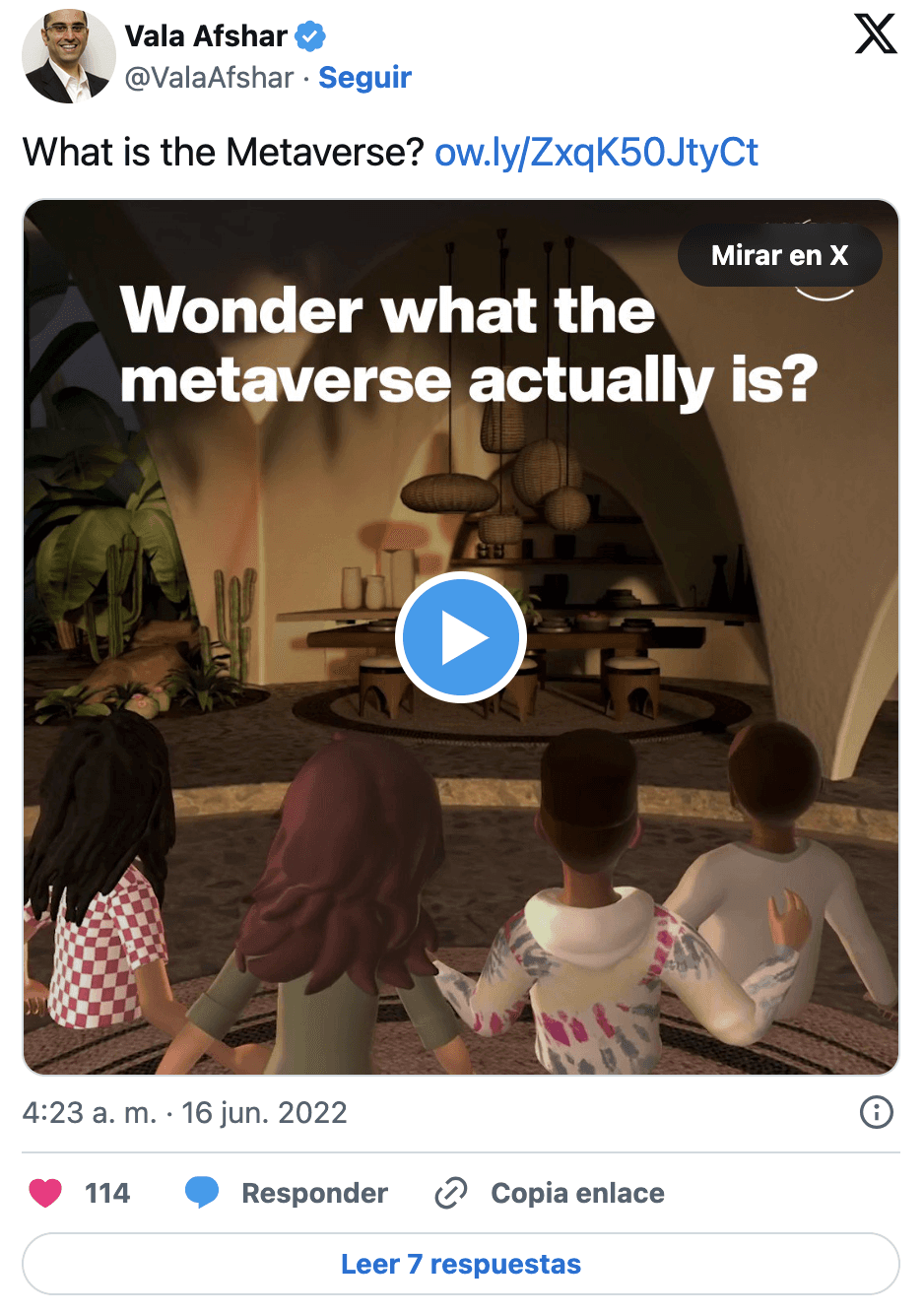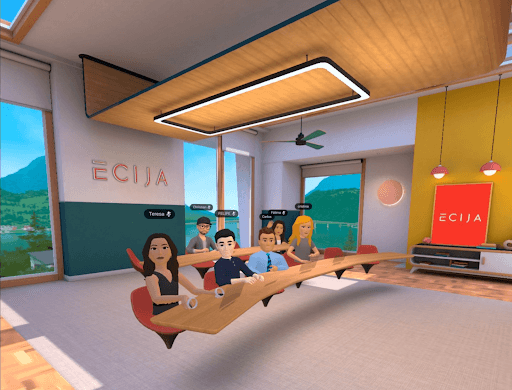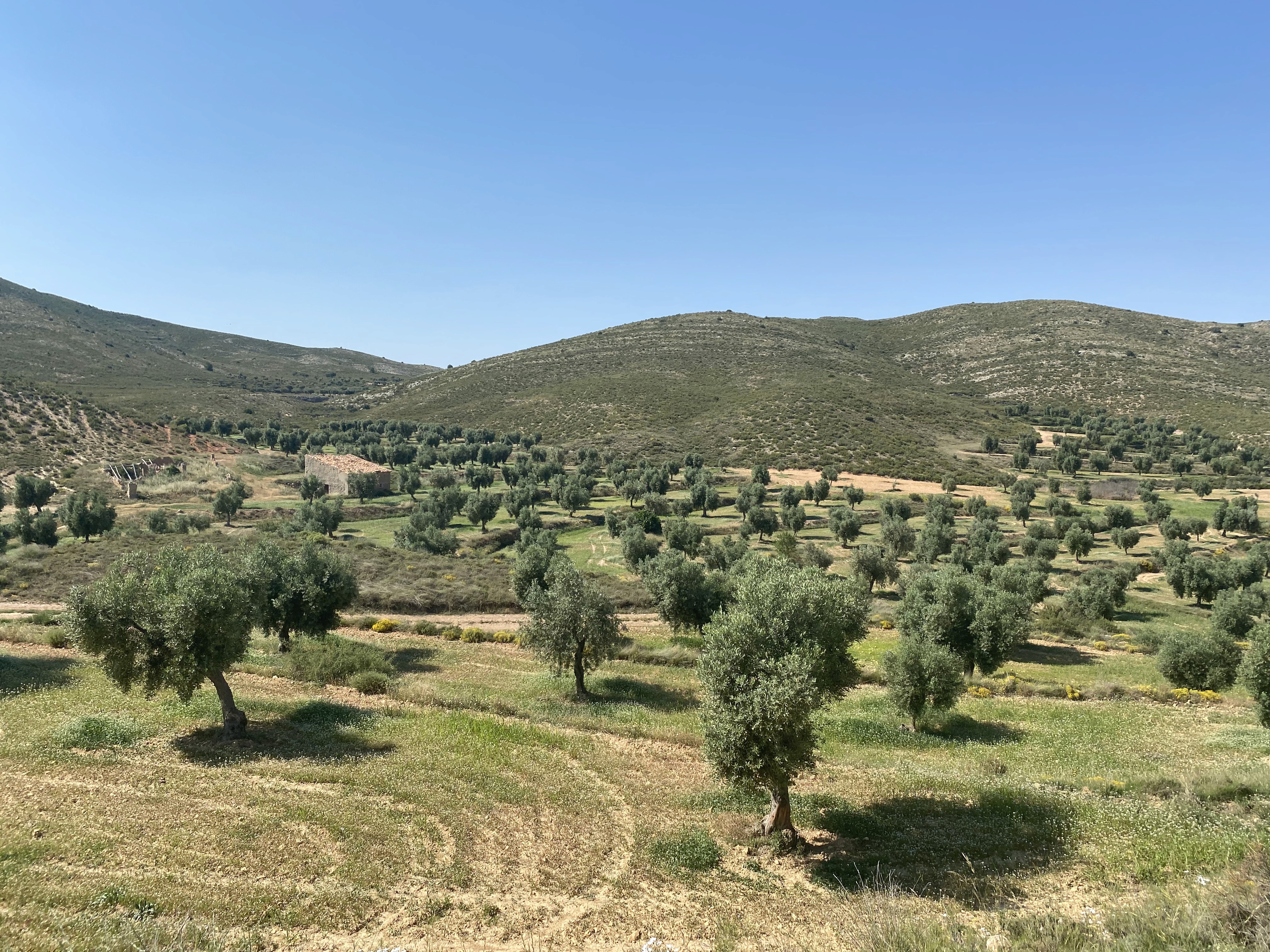Regenerative tourism
Regenerative tourism
Metaverse Destination
Metaverse Destination
25 de octubre de 2022


By Pako Rodríguez, a consultant specialised in tourism, & Javi Creus, founder and strategy director of Ideas for Change. (Original publication in Spanish)
Web 3 and its combination with different technologies brings us the metaverse. With this virtual environment, a new space for interaction opens up between people and between them and the new generated environments. What is the impact on the tourism sector? And, above all, what does the future of the metaverse hold for travel?
In the book From Hospitium to Tourism 4.0, a journey through the history of travel is made, exploring how for thousands of years humans have sought, for various reasons, to meet other people and seek refuge and protection under the shelter of other communities thanks to agreements between peers. According to Harari, this ability for large-scale cooperation and flexibility to adopt changes is what characterises our species and what has allowed us to control the planet.
One thing that the pandemic we are leaving behind has taught us is that humans continue to seek encounters with other people and to know other environments. And this is reflected in the latest data, which points to a much faster recovery of the tourism sector than expected. We want to travel, move, meet and connect to experience.
Internet opened many windows for us to look out from our devices. The Web 1 allowed us to expand our informational capacity at home based on links. The Web 2 widened our social space with likes and the connected movement thanks to mobile devices. The Web 3 immerses us, thanks to blockchain and the combination of other technologies, into new three-dimensional, sensory digital spaces, parallel to reality, where a multitude of data is collected and interaction occurs in a manner previously impossible.

The question arises as to whether these new sensory digital spaces will represent a paradigm shift in these encounters. Whether the different metaverses will be destinations in themselves or whether they will simply serve as support for the marketing of physical destinations and the offerings they contain. The majority of the sources consulted appear to point to the latter. Anyway, it is worth remembering what Albert Cañigueral wrote in this article at the end of last year: “when television arrived, what was done were radio programmes with cameras in front. No one could imagine either the new TV formats or, let alone, the video-on-demand services.” In other words, what is important is not what we think can be done today, but what we will be able to do tomorrow in the metaverse. Zuckerberg, on the contrary, hopes to find in this new parallel reality a substitute for travel. For now, his numbers do not seem to support this bet.
Some data indicate that, in certain aspects of our lives, physical encounters are already giving way to experiences in the metaverse. For example, according to the study “The Metaverse: An Inside View,” Generation Z gamers spend double the time with friends in the metaverse than in real life (12.2 hours a week playing video games compared to 6.6 hours with friends in person). This does not mean that Generation Z no longer wants to travel, as gaming and travel are not mutually exclusive activities. Instead, it indicates that meeting people in our environment in the various spaces offered by the metaverse is already a viable and significant option for some activities.
To see the metaverse in a more practical way, let’s look at some of the uses that are already being made in the travel industry.
Some Uses Related to Tourism
Destinations
Benidorm has become one of the first territories globally to launch its own metaverse. With Benidorm Land, recently launched, the traditional destination seeks to position itself and attract the Generation Z and Alpha segment through the gaming sector, offering, via the Steam platform, a virtual visit to the municipality with their own avatar and where they can interact with objects and get to know the attractions on offer. The aim is to capture this audience and convert them into future visitors.
Decision-Making
In terms of decision-making, combined with what artificial intelligence already offers, travel advisors can use these spaces to meet their potential clients through their respective avatars and become their virtual managers. Coupled with the above, the decision-making regarding travel will become increasingly immersive and hyper-personalised and will help to leave behind the negative surprises that occur when reality does not match what is offered through traditional websites.
Hotels
Very much related to the previous point, for Marriott, the metaverse is a new digital marketing tool that will change the way travellers make their purchases before, during, and after the trip. It will allow users to experience destinations without having to travel physically to the desired site, and they will get to know the experiences that hotels and resorts can offer. The goal is for testing destinations and experiences not to become a substitute but rather a complement.
There are also plans for the creation of virtual meeting and conference rooms as an added value for hotels, which already have extensive experience in MICE tourism and could leverage this knowledge for virtual conferences.
To dress these professional profile avatars, Meta already has an online store with some of the main brands.
For its part, RIU has debuted in the metaverse with its emblematic RIU Plaza de España hotel. Thanks to a virtual experience, one can visit the hotel through the details of the décor, the lobby, or one can go up to its characteristic rooftop. The project has been carried out considering the gamification of the visit, so that it is possible to interact with some elements set up for this purpose. In this video, one can better see what this initiative offers.

The law firm Écija at the first 100% round table in the metaverse among partners from Spain and Latin America. Source and access to the sample video that the firm published on Twitter
Telecommuting
Similarly, and as mentioned at the beginning, it is true that the pandemic has shown us the strong desire to travel that we have. But it has also taught us that telecommuting is a trend that has no turning back or that we can even become more productive without that meeting taking place. And thus believes the CEO of Airbnb, who announced last April that no company employee will have to return to the offices, beyond some quarterly meeting. In other words, working no longer requires physical presence in many sectors and is even compatible with being constantly on the move. The metaverse could become that meeting place for colleagues, replacing Zoom meetings, while real encounters continue to take place while we travel and work from different parts of the world.
Space Travel
Finally, it is worth remembering that the history of travel is an evolution in which, at its outset, only a minority moved, mainly due to the availability of means to do so, and the rest were satisfied with the stories and books that described and made them dream of distant destinations told by those fortunate others who could do so.
Space travel is already a reality and promises to disrupt tourism. For now, it is only accessible for a few wallets. The metaverse could become those new travel books and help us experience space and planets like Mars in a way that future generations will surely be able to live first-hand. NASA has already teamed up with Fortnite creators to carry out this experience that promises to bring a unique experience closer to those of us who, for now, see these types of trips as distant.
These proposals lead us to some conclusions…
The possible futures are unimaginable from a present focused on what is possible today with the technology available today. The metaverse feeds off advancements in artificial intelligence and machine learning, the Internet of Things, virtual and augmented reality to enhance and improve the user experience. The development of quantum computing, edge computing, the Internet of Senses or behaviour and a 6G network that provides all of them with today’s unimaginable transaction speeds open a new range of possibilities by impacting all these technologies exponentially. In other words, there are options that we cannot imagine today thanks to new technological and social combinations that will emerge with these advancements. And, alongside all of this, of course, the data generated with each interaction, the new learnings and the new uses that will arise.
On the contrary, people in the tech world such as Enrique Dans question in this article the potential journey of the metaverse and compare it to the rise and fall of Second Life, a virtual environment that 20 years ago also threatened to change everything but changed very little. Here, aside from the technological jump, it is worth highlighting as a significant difference the adoption of the metaverse by younger generations as something increasingly habitual.
Probably, if we were to read this same article in ten years, we would be surprised at how far we were from what we thought was going to happen. Still, we believe that encounters will remain the essence of humanity. Travel, although possibly limited to the most essential, that is, pleasure or necessity, will continue to be a part of our lives globally and broadly. The metaverse will serve to travel to places where one cannot yet go: space, the past, and probably an imagined future.
From Ideas for Change, we want to continue this conversation. To do this, we will bring together some experts in an upcoming webinar to which you are invited and encouraged to participate by sending questions and comments through our Twitter account. Are you excited?
By Pako Rodríguez, a consultant specialised in tourism, & Javi Creus, founder and strategy director of Ideas for Change. (Original publication in Spanish)
Web 3 and its combination with different technologies brings us the metaverse. With this virtual environment, a new space for interaction opens up between people and between them and the new generated environments. What is the impact on the tourism sector? And, above all, what does the future of the metaverse hold for travel?
In the book From Hospitium to Tourism 4.0, a journey through the history of travel is made, exploring how for thousands of years humans have sought, for various reasons, to meet other people and seek refuge and protection under the shelter of other communities thanks to agreements between peers. According to Harari, this ability for large-scale cooperation and flexibility to adopt changes is what characterises our species and what has allowed us to control the planet.
One thing that the pandemic we are leaving behind has taught us is that humans continue to seek encounters with other people and to know other environments. And this is reflected in the latest data, which points to a much faster recovery of the tourism sector than expected. We want to travel, move, meet and connect to experience.
Internet opened many windows for us to look out from our devices. The Web 1 allowed us to expand our informational capacity at home based on links. The Web 2 widened our social space with likes and the connected movement thanks to mobile devices. The Web 3 immerses us, thanks to blockchain and the combination of other technologies, into new three-dimensional, sensory digital spaces, parallel to reality, where a multitude of data is collected and interaction occurs in a manner previously impossible.

The question arises as to whether these new sensory digital spaces will represent a paradigm shift in these encounters. Whether the different metaverses will be destinations in themselves or whether they will simply serve as support for the marketing of physical destinations and the offerings they contain. The majority of the sources consulted appear to point to the latter. Anyway, it is worth remembering what Albert Cañigueral wrote in this article at the end of last year: “when television arrived, what was done were radio programmes with cameras in front. No one could imagine either the new TV formats or, let alone, the video-on-demand services.” In other words, what is important is not what we think can be done today, but what we will be able to do tomorrow in the metaverse. Zuckerberg, on the contrary, hopes to find in this new parallel reality a substitute for travel. For now, his numbers do not seem to support this bet.
Some data indicate that, in certain aspects of our lives, physical encounters are already giving way to experiences in the metaverse. For example, according to the study “The Metaverse: An Inside View,” Generation Z gamers spend double the time with friends in the metaverse than in real life (12.2 hours a week playing video games compared to 6.6 hours with friends in person). This does not mean that Generation Z no longer wants to travel, as gaming and travel are not mutually exclusive activities. Instead, it indicates that meeting people in our environment in the various spaces offered by the metaverse is already a viable and significant option for some activities.
To see the metaverse in a more practical way, let’s look at some of the uses that are already being made in the travel industry.
Some Uses Related to Tourism
Destinations
Benidorm has become one of the first territories globally to launch its own metaverse. With Benidorm Land, recently launched, the traditional destination seeks to position itself and attract the Generation Z and Alpha segment through the gaming sector, offering, via the Steam platform, a virtual visit to the municipality with their own avatar and where they can interact with objects and get to know the attractions on offer. The aim is to capture this audience and convert them into future visitors.
Decision-Making
In terms of decision-making, combined with what artificial intelligence already offers, travel advisors can use these spaces to meet their potential clients through their respective avatars and become their virtual managers. Coupled with the above, the decision-making regarding travel will become increasingly immersive and hyper-personalised and will help to leave behind the negative surprises that occur when reality does not match what is offered through traditional websites.
Hotels
Very much related to the previous point, for Marriott, the metaverse is a new digital marketing tool that will change the way travellers make their purchases before, during, and after the trip. It will allow users to experience destinations without having to travel physically to the desired site, and they will get to know the experiences that hotels and resorts can offer. The goal is for testing destinations and experiences not to become a substitute but rather a complement.
There are also plans for the creation of virtual meeting and conference rooms as an added value for hotels, which already have extensive experience in MICE tourism and could leverage this knowledge for virtual conferences.
To dress these professional profile avatars, Meta already has an online store with some of the main brands.
For its part, RIU has debuted in the metaverse with its emblematic RIU Plaza de España hotel. Thanks to a virtual experience, one can visit the hotel through the details of the décor, the lobby, or one can go up to its characteristic rooftop. The project has been carried out considering the gamification of the visit, so that it is possible to interact with some elements set up for this purpose. In this video, one can better see what this initiative offers.

The law firm Écija at the first 100% round table in the metaverse among partners from Spain and Latin America. Source and access to the sample video that the firm published on Twitter
Telecommuting
Similarly, and as mentioned at the beginning, it is true that the pandemic has shown us the strong desire to travel that we have. But it has also taught us that telecommuting is a trend that has no turning back or that we can even become more productive without that meeting taking place. And thus believes the CEO of Airbnb, who announced last April that no company employee will have to return to the offices, beyond some quarterly meeting. In other words, working no longer requires physical presence in many sectors and is even compatible with being constantly on the move. The metaverse could become that meeting place for colleagues, replacing Zoom meetings, while real encounters continue to take place while we travel and work from different parts of the world.
Space Travel
Finally, it is worth remembering that the history of travel is an evolution in which, at its outset, only a minority moved, mainly due to the availability of means to do so, and the rest were satisfied with the stories and books that described and made them dream of distant destinations told by those fortunate others who could do so.
Space travel is already a reality and promises to disrupt tourism. For now, it is only accessible for a few wallets. The metaverse could become those new travel books and help us experience space and planets like Mars in a way that future generations will surely be able to live first-hand. NASA has already teamed up with Fortnite creators to carry out this experience that promises to bring a unique experience closer to those of us who, for now, see these types of trips as distant.
These proposals lead us to some conclusions…
The possible futures are unimaginable from a present focused on what is possible today with the technology available today. The metaverse feeds off advancements in artificial intelligence and machine learning, the Internet of Things, virtual and augmented reality to enhance and improve the user experience. The development of quantum computing, edge computing, the Internet of Senses or behaviour and a 6G network that provides all of them with today’s unimaginable transaction speeds open a new range of possibilities by impacting all these technologies exponentially. In other words, there are options that we cannot imagine today thanks to new technological and social combinations that will emerge with these advancements. And, alongside all of this, of course, the data generated with each interaction, the new learnings and the new uses that will arise.
On the contrary, people in the tech world such as Enrique Dans question in this article the potential journey of the metaverse and compare it to the rise and fall of Second Life, a virtual environment that 20 years ago also threatened to change everything but changed very little. Here, aside from the technological jump, it is worth highlighting as a significant difference the adoption of the metaverse by younger generations as something increasingly habitual.
Probably, if we were to read this same article in ten years, we would be surprised at how far we were from what we thought was going to happen. Still, we believe that encounters will remain the essence of humanity. Travel, although possibly limited to the most essential, that is, pleasure or necessity, will continue to be a part of our lives globally and broadly. The metaverse will serve to travel to places where one cannot yet go: space, the past, and probably an imagined future.
From Ideas for Change, we want to continue this conversation. To do this, we will bring together some experts in an upcoming webinar to which you are invited and encouraged to participate by sending questions and comments through our Twitter account. Are you excited?


